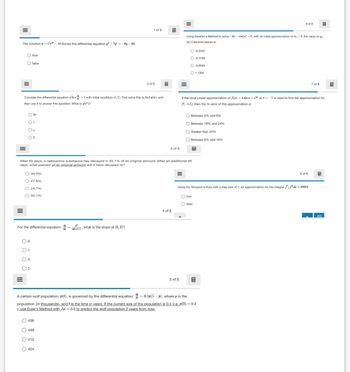
Calculus: Early Transcendentals
8th Edition
ISBN: 9781285741550
Author: James Stewart
Publisher: Cengage Learning
expand_more
expand_more
format_list_bulleted
Question

Transcribed Image Text:III
The function y = Ce-10 Solves the differential equation 3"-7=-6y - 60.
true
false
6 of 8
1 of 8
Using Newton's Method to solve -3x-cos(x) = 0, with an initial approximation of z₁ =
(to 4 decimal places is:
the value of
2 of 8
Consider the differential equation In = 1 with initial condition (e, 1). First solve this to find y(2), and
then use it to answer this question: What is y(e)?
2e
○ 1
○ e
2
-0.3332
O-0.3168
-0.6948
1.1394
7 of 8
If the local Linear approximation of f(x)=4sin x+e at = -1 is used to find the approximation for
f(-1.1), then the % error of this approximation is
Between 0% and 8%
Between 16% and 24%
O Greater than 24%
Between 8% and 16%
3 of 8
After 45 days, a radioactive substance has decayed in 55.1% of its original amount. After an additional 45
days, what percent of its original amount will it have decayed to?
30.4%
27.6%
24.7%
55.1%
For the differential equation: +1, what is the slope at (0,2)?
01
○ 4
○ 2
8 of 8
Using the Simpson's Rule with a step size of 1, an approximation for the integral de 30852,
true
Ofalse
4 of 8
=
A certain wolf population, p(t), is governed by the differential equation:
5 of 8
0.1p(1 - p), where p is the
population (in thousands), and t is the time in years. If the current size of the population is 0.4 (i.e. p(0) = 0.4
), use Euler's Method with At=0.5 to predict the wolf population 2 years from now.
436
449
412
424
Expert Solution
This question has been solved!
Explore an expertly crafted, step-by-step solution for a thorough understanding of key concepts.
Step by stepSolved in 2 steps with 2 images

Knowledge Booster
Similar questions
Recommended textbooks for you
 Calculus: Early TranscendentalsCalculusISBN:9781285741550Author:James StewartPublisher:Cengage Learning
Calculus: Early TranscendentalsCalculusISBN:9781285741550Author:James StewartPublisher:Cengage Learning Thomas' Calculus (14th Edition)CalculusISBN:9780134438986Author:Joel R. Hass, Christopher E. Heil, Maurice D. WeirPublisher:PEARSON
Thomas' Calculus (14th Edition)CalculusISBN:9780134438986Author:Joel R. Hass, Christopher E. Heil, Maurice D. WeirPublisher:PEARSON Calculus: Early Transcendentals (3rd Edition)CalculusISBN:9780134763644Author:William L. Briggs, Lyle Cochran, Bernard Gillett, Eric SchulzPublisher:PEARSON
Calculus: Early Transcendentals (3rd Edition)CalculusISBN:9780134763644Author:William L. Briggs, Lyle Cochran, Bernard Gillett, Eric SchulzPublisher:PEARSON Calculus: Early TranscendentalsCalculusISBN:9781319050740Author:Jon Rogawski, Colin Adams, Robert FranzosaPublisher:W. H. Freeman
Calculus: Early TranscendentalsCalculusISBN:9781319050740Author:Jon Rogawski, Colin Adams, Robert FranzosaPublisher:W. H. Freeman
 Calculus: Early Transcendental FunctionsCalculusISBN:9781337552516Author:Ron Larson, Bruce H. EdwardsPublisher:Cengage Learning
Calculus: Early Transcendental FunctionsCalculusISBN:9781337552516Author:Ron Larson, Bruce H. EdwardsPublisher:Cengage Learning

Calculus: Early Transcendentals
Calculus
ISBN:9781285741550
Author:James Stewart
Publisher:Cengage Learning

Thomas' Calculus (14th Edition)
Calculus
ISBN:9780134438986
Author:Joel R. Hass, Christopher E. Heil, Maurice D. Weir
Publisher:PEARSON

Calculus: Early Transcendentals (3rd Edition)
Calculus
ISBN:9780134763644
Author:William L. Briggs, Lyle Cochran, Bernard Gillett, Eric Schulz
Publisher:PEARSON

Calculus: Early Transcendentals
Calculus
ISBN:9781319050740
Author:Jon Rogawski, Colin Adams, Robert Franzosa
Publisher:W. H. Freeman


Calculus: Early Transcendental Functions
Calculus
ISBN:9781337552516
Author:Ron Larson, Bruce H. Edwards
Publisher:Cengage Learning